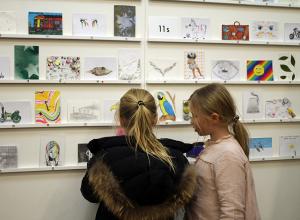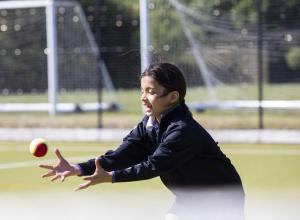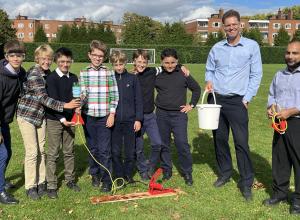
Since I returned to England, after some years working in Thailand, the cultural influence has lingered on in various ways. I still love the spices and the beaches but it’s the people and their outlook on life that are truly unforgettable. Two phrases encapsulate the essence of Thai culture for me. ‘Jai yen yen’ equates to a cool heart or in other words, remaining calm. ‘Mai pen rai’ means no worries. They’re both in my mind, inspiring me as I work. Teaching children provides a wonderful unpredictability to the day, as children see the world in amazingly different ways. But as a teacher it’s also vital to remain calm and not to worry about everything. Be calm, don’t worry. Essential starting points!
It’s a third phrase that I learnt in Thailand that is the focus of this blog. It is a phrase spoken in English and not in Thai.
'Same-same but different', is a Thai phrase (but spoken in English) used to describe things that are similar, yet not exactly so.
It is often heard in markets as part of the negotiation process. If an item you want is not available for one reason or another, you may be offered a something similar, something close to what you wanted, but not identical. Same-same...but different.
So then, what does this phrase have to do with a mastery blog? I am fortunate enough to be working with an incredible team of Maths teachers. Each of them is dedicated, knowledgeable and caring but each is, inevitably, also a unique individual shaped by diverse experience into his or her own particular ways of seeing the world and teaching children. It seems to me bizarre to ask any one of us to try and teach the way another does. Yet, in schools across the country, this type of ‘equality of opportunity’ is regarded as desirable.
It seems to me bizarre to ask any one of us to try and teach the way another does. Yet, in schools across the country, this is regarded as desirable.
The notion first began as part of the new national curriculum. The idea that a child could move from one place of the country to another without missing a beat in terms of their lessons was viewed as advantageous. There is a logic to this. The national curriculum meant that children could not be disadvantaged by location or in the skills they were taught because there was a basic requirement that all teachers and schools had to meet. In this instance same-same is good.
But what was lost in this proposal was the knowledge that children are inherently different and have different needs, not just from county to county but from class to class. Equally, teachers bring with them different experiences and different strengths, which they apply to their classes in an effort to inspire. Both state and independent schools have often attempted to get teachers planning together so that the teaching sequence was similar if not identical and, under such organisation, it became easier for teachers to plan. Easier for teachers to resource. Easier for schools to monitor. But as I see it, in this instance, ‘easy’ is not in the best interest of the pupils. The beauty of a child and his or her mind is that they are each unique, one of a kind. We cannot teach in 22 different ways in a class of 22, it’s true but we can consider the differences in our students and in our own styles. In this case, then, same-same is not good.
The beauty of a child and his or her mind is that they are each unique, one of a kind.
Mastery adds an important extra layer to what is already a rather tumultuous landscape. At Harrodian, mastery brings with it a very important aspect of ‘sameness’ but also with a difference. We want our students to take the same national curriculum that all pupils do, but we want them to view the subject and the curriculum through the Mastery lens. That means learning and experiencing Mathematics through five key shared learning methods which we use in our lessons. These five pillars of mastery are set below with a little more explanation which I hope may clarify what I’m getting at.
Mastery means learning and experiencing Mathematics through five key shared learning methods which we use in our lessons, though not all five will necessarily be used in a single lesson.
- Metacognition: this involves asking the students to think about their own thinking, which is essentially reflecting upon what and why they are doing the things that they do. This reflection allows a student to carefully consider the process they are studying and why they are making the decisions they are in trying to find an answer. This becomes key in applying skills to new contexts. Equally important is how metacognition helps students identify possible limitations and build their own ideas on where they need further development, which is a significant skill for all.
- Visualisation is a two-fold concept within mastery. First, it involves the movement from concrete objects to picture representation and model-making. In doing so, a deeper level of understanding can be gained which is the precursor for students working with abstractions in their lessons. Abstractions flood everyday mathematics lessons; for the most part we do not even think about abstractions as abstractions (a digit form of a number is an abstraction as it represents a quantity, for example). The second aspect of visualisation involves using real-world examples so that students can ‘see’ the Maths around them and the impact it has. If you remember the problem with the tea I highlighted in my last blog, you will know it is vital that problems are rooted in reality so our students can make connections that deepen their understanding.
- Generalisation: generalising involves taking a specific example and building a rule based on what pupils uncover. In doing so, they are able to test their rule with other specific examples leading to greater understanding of how the rule is applied and what exceptions to the rule may look like. The idea is that students start to uncover the rules of mathematics themselves, working to prove their own theories correct.
- Number sense: Traditional notions of mathematics have often viewed number as static, as fixed. But within mastery, number is viewed as fluid flexible and that the meaning assigned to a number requires significant reasoning. A number’s value can ‘depend’ on context. Is it a little? Is it a lot? Well, it depends on the details surrounding the use of the number. Strong number sense allows students to see the possibilities and impossibilities of a question before they even need to calculate. It also allows them to spot errors on their own after they have completed tasks.
- Communication: Finally, communication involves our students discussing, disagreeing and developing ideas with each other. Our students are given frequent opportunities to analyse and synthesize in an effort for them to deepen their understanding through their own explanations whilst extending their learning by listening to their peers. The ‘give and take’ in a conversation between partners is a powerful learning process and amongst peers it tends to spiral both participants to greater levels of understanding.
It's important to point out that we would not expect all five ingredients to be included in a single lesson. Depending on student needs, a teacher may spend longer in one area than another.
But, as a group of lessons unfold, we will have provided the opportunity for all of our students to experience each of the key concepts. The way this looks will vary from class to class but I hope you will agree that this is both a good thing and an absolutely necessity for student development.
Same-same but different, as it applies in a mathematical context, is all about balance. Sometimes, a very delicate balance.
For me the idea of Same-same but different, as it applies in a mathematical context, is all about balance. Sometimes, a very delicate balance. I believe the ideal learning environment is a place where teachers view mathematics in a similar way, where high standards and the ability to add flair and excitement to lessons are valued, and where teachers can draw on personal experience in order to enrich lessons and enlighten students. I am happy to say this is just the context we are creating within Lower Prep mathematics at Harrodian. I’m confident it will lead to our students loving Maths as well as reaching their full potential.







